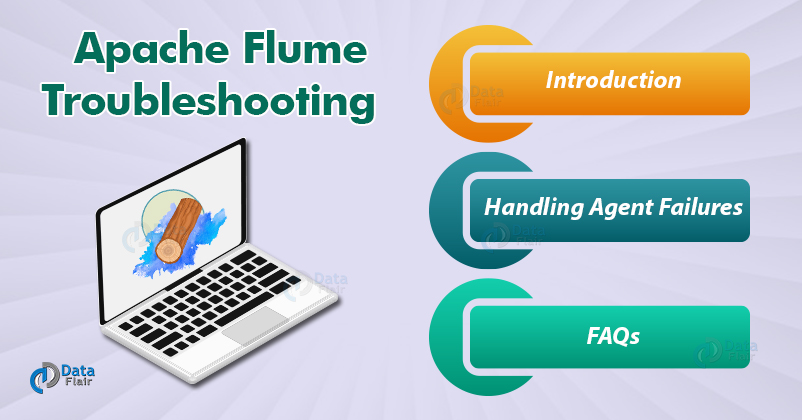Flume Troubleshooting | Flume Known Issues & Its Compatibility
While working with the Apache Flume, some problems may arise. In this article, we will see how to perform Flume Troubleshooting. The article explains how to handle agent failures in Apache Flume known issues. The article also describes. At Troubleshooting FAQ.
Apache Flume Troubleshooting
Troubleshooting refers to the systematic approach to solving problems. Troubleshooting is useful for finding and correcting issues occurring in complex machines, computers, electronics, and software systems.
Let us see how to troubleshoot the problem of agent failure in Apache Flume.
Apache Flume Troubleshooting- Handling agent Failures
In Apache Flume, if in case the Flume agent goes down, then in such a case all the flows that are hosted on that flume agent are aborted. The flow will resume once the agent restarts.
The flow which is using either the file channel or the other stable channel will start processing flume events from where it left off.
If in case the flume agent cannot be restarted on the same hardware, then in such a case there is an option of migrating the database to the other hardware. And a new Flume agent is set that resumes the processing of the flume events in the database.
In this manner, Flume handles the agent failure.
Flume Troubleshooting FAQ
There are some Frequently Asked Questions while debugging the operations of a running Apache Flume cluster. This Flume Troubleshooting FAQ will cover all such questions.
1. Configuration and Setting FAQ
a. How can I tell if I have a library loaded when the flume runs?
From the command line, we can run the flume classpath. By running this we will be able to see the jars and the order the Apache Flume is attempting to load them in.
b. How can I tell if a plugin has been loaded by a flume node?
For this we can look at the node’s plugin status web page – http://<master>:35871/extension.jsp
Another alternative is to look at the logs.
c. Why does the master need to have plugins installed?
To validate the configs which the master is sending to nodes, the master needs to have plugins installed.
d. How can I tell if a plugin has been loaded by a flume master?
For this we can look at the node’s plugin status web page – http://<master>:35871/masterext.jsp
Another alternative is to look at the logs.
e. How can I tell if my flume-site.xml configuration values are being read properly?
For this, we can go to the master’s or node static config web page to see what configuration values are there.
http://<node>:35862/staticconfig.jsp
http://<master>:35871/masterstaticconfig.jsp
f. I’m having a hard time getting the LZO codec to work.
By default, Flume reads the $HADOOP_CONF_DIR/core-site.xml. This directory may have the io.compression.codecs setting set. We can make the setting <final> so that flume does not make attempts to override the setting.
2. Operations FAQ
a. How can I get metrics from a node?
Flume nodes report metrics which we can use for debugging and seeing progress. We can have a look at the node’s status web page by pointing our browser to the port 35862. (http://<node>:35862).
b. How can I tell if data is arriving at the collector?
When the events arrive at a collector, then the source counters must be incremented on the node’s metric page. Consider an example where we have a node called demo. On refreshing the page, we should see the following fields have growing values.
1. LogicalNodeManager.demo.source.CollectorSource.number of bytes
2. LogicalNodeManager.demo.source.CollectorSource.number of events
c. How can I tell if data is being written to HDFS?
Data in HDFS does not “arrive” in HDFS until the file gets closed or the certain size thresholds are met. As events were written to HDFS, the flume sink counters on the collector’s metric page should be incrementing.
Look for fields that match the following names:
*.Collector.GunzipDecorator.UnbatchingDecorator.AckChecksumChecker.InsistentAppend.append*
*.appendSuccesses are successful writers. If in case other values like appendGiveups or appendRetries are incremented, then it indicates a problem with the attempt to write.
d. I have encountered a “Could not increment version counter” error message.
This is a zookeeper issue. It seems related to virtual machines or the machines that change IP addresses while running. This occurs only in a development environment – the workaround here is to restart the master.
Summary
Thus now we are aware of the possible Flume Troubleshooting steps. The article describes what is troubleshooting. It had clearly explained how to troubleshoot flume agent failure. The article had also enlisted some important Flume troubleshooting FAQ. I hope this article will help you to solve your issues encountered while running flume.
Do share your Feedback in the comment section if you liek the article.
Did you know we work 24x7 to provide you best tutorials
Please encourage us - write a review on Google


